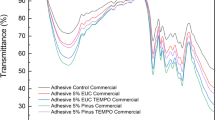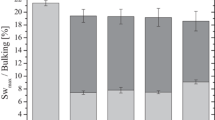Abstract
The phlobaphenes formation and precipation during sulphite/water extraction of pine tannins from pine bark was minimized by blocking tannin self-condensation by the addition of small amounts of a strong nucleophile such as phloroglucinol, m-phenylenediamine and urea, the latter due to its low cost for industrial application. These inhibitors reacted preferentially with the reaction intermediates formed in the tannins self-condensation mechanism, stopping the reaction reaching the molecular rearranged precipates known as phlobaphenes. The principle of inhibition appears to be effective at both the laboratory and industrial level. The results of laboratory and industrial extractions and the results of the adhesives from the modified pine tannin extract/urea adducts obtained are presented. The pine tannin/urea extracts proved to yield good thermosetting wood adhesives for panel products. The minimization of phlobaphenes precipitation increased the yield from 19% to 25% industrial scale.
Zusammenfassung
Die Bildung und Ausfällung von Phlobaphenen während der Extraktion von Kiefernrinde wurde verringert durch Blockieren der Tanninkondensation durch geringe Zusätze stark nukleophiler Reagentien wie Phloroglucin, m-Phenylendiamin und Harnstoff (letzterer wegen der geringen Kosten für die industrielle Herstellung). Diese Inhibitoren reagierten vor allem mit Zwischenprodukten der Tanninkondensation. Dabei wird die Bildung der durch molekulare Umlagerungen entstehenden Phlobaphene gestoppt. Die Unterdrückung der Phlobaphenbildung gelingt sowohl im Labor- als auch im technischen Maßstab. Die Ergebnisse der Extraktion und der Leimherstellung aus diesen modifizierten Tanninen mit Harnstoffzusatz werden beschrieben. Diese Kleber eignen sich gut zur Heißverleimung von Platten. Aufgrund der Unterdrükkung der Phlobaphenbildung erhöhte sich die Ausbeute der technischen Extraktion von 19 auf 25%.
Similar content being viewed by others
References
Baeza, J.: University of Concepcion. Chile, private communication 1990
Brown, R.; Cummings, W.: Polymerization of flavans. Part II: The condensation of 4′-methoxyflavan with phenols. J. Chem. Soc. (1958) 4302
Brown, R.; Cummings, W.; Newbould, J.: Polymerization of flavans. Part IV: The condensation of flavan-4-ols with phenols. J. Chem. Soc. (1961) 3677
Foo, L. Y.; Karchesy, J. J.: Chemical nature of phlobaphenes. In: Hemingway, R. W.; Karchesy, J. J. (Eds.). New York: Plenum Press 1989
Foo, L. Y.; McGraw, G. W.; Hemingway, R. W.: Condensed Tannins: preferential substitution at the interflavonoid bond by sulphite ion. J. Chem. Soc., Chem. Comm. (1983) 672~673
Freudenberg, K.; Alonso de Lama, J.: Tannin catechins. Annalen, 612 (1958) 78
Hemingway, R. W.; Foo, L. Y.: Condensed tannins: quinone methide intermediates in procyanidin synthesis. J. Chem. Soc. Chem. Comm. (1983) 1035~1036
Hemingway, R. W.; Laks, P. E.; McGraw, G. W.; Kreibich, R. E.: Condensed tannins: problems and prospects for their extended use in wood adhesives in, Wood adhesives in 1985: status and needs, Proceedings of Forest Products Research Society Symposium, Madison, Wisconsin, May 1985 (1985) 159~169
Hemingway, R. W.; McGraw, G. W.: Kinetics of acid-catalyzed cleavage of procyanidins. J. Wood Chem. Technol. 3 (4) (1983) 421–435
Mayer, W.; Merger, F.: Die Reaktion der catechine met phloroglucin. Liebigs Annalen der Chemie, B644, N (1961) 70–78
Pizzi, A.: Pine tannin adhesives for Particleboard. Holz Roh-Werkstoff. 40 (1982) 293–301
Pizzi, A.: Tannin-based wood adhesives. Chapter 4 in: Wood adhesives chemistry and technology, Pizzi, A. (Ed.). New York: Marcel Dekker Inc. 1983
Pizzi, A.; Rossouw, D. du T.; Knuffel, W.; Singmin, M.: “Honeymoon” phenolic and tannin-based fast-setting adhesive systems for exterior grade fingerjoints. Holzforschung und Holzverwertung. 32 (1980) 140
Pizzi, A.; von Leyser, E.; Valenzuela, J.; Clark, J. G.: The chemistry and development of pine tannin adhesives for exterior particleboard. J. Appl. Polym. Sci., Submitted for publication 1991
Rossouw, D. du T.: Ontwikkeling van dennelooistoflym, CSIR special report HOUT 137 (1977) pp. 1~34. Pretoria, South Africa
Rossouw, D. du T.: Looistofinhoud en-gehalte van Suid Afrikaanse dennebos. CSIR special report HOUT 163 (1978) pp. 1~12. Pretoria, South Africa
Roux, D. G.: Activation of some condensed tannins via facile ring isomerizations, Chapter 16 in: Hemingway, R. W.; Conner, A. H. (Eds.). Adhesives from renewable resources. ACS Symposium Series Nr. 385 (1989) pp. 217–218. Washington D. C.: American Chemical Society
Roux, D. G.; Ferreira, D.; Hundt, H. K. L.; Malan, E.: Structure, stereo-chemistry and reactivity of natural condensed tannins as basis of their extended industrial exploitation. Polymer Symposium No. 28, Proceedings of the Eighth Cellulose Conference, Part I 1975
Schroeder, H. A.: Pine tannin adhesives. CSIR special report HOUT 120 (1976) pp. 1~12, pretoria, South Africa
Sealy-Fisher, V. J.: Industrial polymers based on pine tannin phlobaphenes. M. Sc. Thesis, (1991) pp. 1–280. University of the Witwatersrand: Johannesburg, South Africa
Steenkamp, J. A.; Steynberg, J. P.; Brandt, E. V.; Ferreira, D.; Roux, D. G.: Phlobatannins, a novel class of ring-isomerized condensed tannins, J. Chem. Soc., Chem. Comm., (1985) 1678
Steynberg, J. P.; Young, D. A.; Burger, J. F. W.; Ferreira, D.; Roux, D. G.: Phlobatannins via facile ring isomerization of profisetinidin and prorobinetidin condensed tannin units. J. Chem. Soc., Chem. Comm., (1986) 1013
von Leyser, E.; Pizzi, A.: The formulation and commercialisation of glulam pine tannin adhesives in Chile. Holz Roh- Werkstoff, 48 (1990) 25–29
Young, D. A.; Cronje, A.; Botes, A. L.; Ferreira, D.; Roux, D. G.: Synthesis of condensed tannins, part 14: Biflavonoid profisetinidins as synthons. The acid induced “phlobaphene” reaction. J. Chem. Soc., Perkin Trans. I (1985) 2521
British Standard: BS 1204-1965 Part 2: Specification for synthetic resins adhesives for wood 1965
South African Bureau of Standards: SABS 096-1976: Specification for the manufacture of finger-jointed structural timber. 1~18: Pretoria, South Africa 1976
South African Bureau of Standards: SABS 1349-1981: Specification for Phenolic and Aminoplastic Adhesives for the laminating and fingerjointing of Timber 1981
Author information
Authors and Affiliations
Rights and permissions
About this article
Cite this article
Sealy-Fisher, V.J., Pizzi, A. Increased pine tannins extraction and wood adhesives development by phlobaphenes minimization. Holz als Roh-und Werkstoff 50, 212–220 (1992). https://doi.org/10.1007/BF02663290
Issue Date:
DOI: https://doi.org/10.1007/BF02663290




